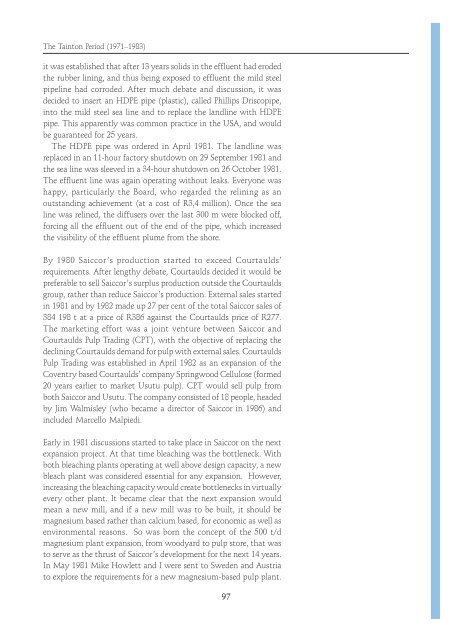Create successful ePaper yourself
Turn your PDF publications into a flip-book with our unique Google optimized e-Paper software.
<strong>The</strong> Tainton Period (1971–1983)<br />
it was established that after 13 years solids in the effluent had eroded<br />
the rubber lining, and thus being exposed to effluent the mild steel<br />
pipeline had corroded� After much debate and discussion, it was<br />
decided to insert an HDPE pipe (plastic), called Phillips Driscopipe,<br />
into the mild steel sea line and to replace the landline with HDPE<br />
pipe� This apparently was common practice in the USA, and would<br />
be guaranteed for 25 years�<br />
<strong>The</strong> HDPE pipe was ordered in April 1981� <strong>The</strong> landline was<br />
replaced in an 11-hour factory shutdown on 29 September 1981 and<br />
the sea line was sleeved in a 34-hour shutdown on 26 October 1981�<br />
<strong>The</strong> effluent line was again operating without leaks� Everyone was<br />
happy, particularly the Board, who regarded the relining as an<br />
outstanding achievement (at a cost of R3,4 million)� Once the sea<br />
line was relined, the diffusers over the last 300 m were blocked off,<br />
forcing all the effluent out of the end of the pipe, which increased<br />
the visibility of the effluent plume from the shore�<br />
By 1980 <strong>Saiccor</strong>’s production started to exceed Courtaulds’<br />
requirements� After lengthy debate, Courtaulds decided it would be<br />
preferable to sell <strong>Saiccor</strong>’s surplus production outside the Courtaulds<br />
group, rather than reduce <strong>Saiccor</strong>’s production� External sales started<br />
in 1981 and by 1982 made up 27 per cent of the total <strong>Saiccor</strong> sales of<br />
384 198 t at a price of R386 against the Courtaulds price of R277�<br />
<strong>The</strong> marketing effort was a joint venture between <strong>Saiccor</strong> and<br />
Courtaulds Pulp Trading (CPT), with the objective of replacing the<br />
declining Courtaulds demand for pulp with external sales� Courtaulds<br />
Pulp Trading was established in April 1982 as an expansion of the<br />
Coventry based Courtaulds’ company Springwood Cellulose (formed<br />
20 years earlier to market Usutu pulp)� CPT would sell pulp from<br />
both <strong>Saiccor</strong> and Usutu� <strong>The</strong> company consisted of 18 people, headed<br />
by Jim Walmisley (who became a director of <strong>Saiccor</strong> in 1986) and<br />
included Marcello Malpiedi�<br />
Early in 1981 discussions started to take place in <strong>Saiccor</strong> on the next<br />
expansion project� At that time bleaching was the bottleneck� With<br />
both bleaching plants operating at well above design capacity, a new<br />
bleach plant was considered essential for any expansion� However,<br />
increasing the bleaching capacity would create bottlenecks in virtually<br />
every other plant� It became clear that the next expansion would<br />
mean a new mill, and if a new mill was to be built, it should be<br />
magnesium based rather than calcium based, for economic as well as<br />
environmental reasons� So was born the concept of the <strong>50</strong>0 t/d<br />
magnesium plant expansion, from woodyard to pulp store, that was<br />
to serve as the thrust of <strong>Saiccor</strong>’s development for the next 14 years�<br />
In May 1981 Mike Howlett and I were sent to Sweden and Austria<br />
to explore the requirements for a new magnesium-based pulp plant�<br />
97

















